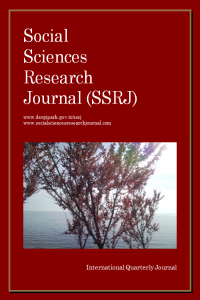Dijital Sürdürülebilirlik, Boyutları ve Koşulları
Dijital sürdürülebilirlik, Dijital Ürünler, Dijital İş Modelleri, Erişim, Bulut Bilişim, Temel Koşullar
Digital Sustainability, Its Dimensions and Conditions
Digital Sustainability, Digital Artifacts, Digital Business Models, Access, Cloud Compiting, Basic Conditions,
___
- Referans1 Bates, J. (2012). This is what modern deregulation looks like: co-optation and contestation in the shaping of the UK’s Open Government Data Initiative. The Journal of Community Informatics. 8 (2). https://openjournals.uwaterloo.ca/index.php/JoCI/article/view/3038/3941
- Referans2 Bradley, K. (2007). Defining Sustainability. Library Trends, Cilt.56, Sayı:1, 148-163.
- Referans3 Bunkell, J. and Dyas-Correia, S. (2009). E-books vs. print: which is the better value?.The Serials Librarian, 56:1-4, pp. 215-219. DOI: 10.1080/03615260802698283
- Referans4 Chandola, V. (2015). Digital Transformation and Sustainability: Study and Analysis. Harvard University Research Paper, Cambridge, Massachusetts. DOI: 10.13140/RG.2.1.3358.0567
- Referans5 Chowdhury, G. (2010).Carbon footprint of the knowledge sector: what’s the future?. Journal of Documentation, 66(6), 934-946.
- Referans6 Chowdhury, G.G. (2012). An agenda for green information retrieval research. Information Processing and Management, 48 (6), 1067-1077.
- Referans7 Chowdhury, G. (2013). Sustainability of Digital Information Servicces, Journal of Documentation, 69 (5), 602-622. DOI 10.1108/JD-08-2012-0104.
- Referans8 Dapp, M. (2013). Open Government Data and Free Software – Cornerstones of a Digital Sustainability Agenda,1-6.
- Referans9 Gombiner, J. (2011).Carbon footprinting the internet. Consilience: The Journal of Sustainable Development, 5(1), 119-124.
- Referans10 I-scoop (2016). Digitization, digitalization and digital transformation: the differences. https://www.i-scoop.eu/digitization-digitalizationdigital-transformation-disruption/ Erişim: 12.04.2021
- Referans11 Ingwersen, P. (1996).Cognitive perspectives of information retrieval interaction: elements of a cognitive IP theory. Journal of Documentation, 52 (1), 3-50.
- Referans12Janovic, M., Diacic, J. ve Okanovic, M. (2018). Digitalization and Society’s Sustainable Development – Measures and Implications, Zb. rad. Ekon. fak. Rij. 36(2), 905-928. https://doi.org/10.18045/zbefri.2018.2.905
- Referans13 Koçoğlu Sazkaya, M. (2019). Dijital Sürdürülebilirlik. Mendeş Pekdemir, I. (Ed.) Dijital Dönüşüm içinde (261-288). İstanbul; Beta Yayıncılık.
- Referans14 Patnaik, A. (2018). Sustainable Digitalization. Journal of Emerging Technologies and Innovative Research (JETIR), Cilt: 5, Sayı:7, 1418-1422.
- Referans15 PcMag (2011). How Much Electricity Does Google Consume Each Year? https://www.pcmag.com/archive/how-much-electricity-does-google-consume-each-year-287468 Erişim tarihi: 12.04.2021
- Referans16 Raghavan, B. ve Ma, J. (2011). The energy and emergy of the internet, In Proceedings of the 10th ACM Workshop on Hot Topics in Networks (HotNets-X). Association for Computing Machinery, New York, NY, USA, 9, 1–6. DOI:https://doi.org/10.1145/2070562.
- Referans17 Schollmeier, R. (2001). A definition of peer-to-peer networking for the classification of peer-to-peer architectures and applications. In: Peer-to-peer computing, 2001. Proceedings of first international conference on IEEE, 101–102. https://ieeexplore.ieee.org/document/990434
- Referans18 Schwab, K. (2016) The Fourth Industrial Revolution, Geneva: World Economic Forum. https://www.weforum.org/agenda/2016/01/the-fourth-industrial-revolution-what-it-means-and-how-to-respond/ Erişim Tarihi: 26.02.2021
- Referans19 Sinha, P., Schew, W.A., Sawant, A., Kolwaite, K.J. ve Strode, S.A. (2010), Greenhouse gas emissions from US institutions of higher education, Journal of Air & Waste Management Association, 60 (5), 568-573.
- Referans20 Stuermer, M. (2014). Characteristics of Digital Sustainability. ICEGOV '14: Proceedings of the 8th International Conference on Theory and Practice of Electronic Governance October 2014, 494–495. https://doi.org/10.1145/2691195.2691269.
- Referans21 Stuermer, M., Abu-Tayeh, G. (2016). Digital Preservation through Digital Sustainability. iPRES. DOI:10.7892/boris.98845
- Referans22 Stuermer, M., Abu-Tayeh, G. Ve Myrach, T. (2017). Digital Sustainability: Basic Conditions for Sustainable Digital Artifacts and Their Ecosystems, Sustainability Science, 12, 247–262. https://doi.org/10.1007/s11625-016-0412-2
- Referans23 The Economist (1999). Catch the wave: The long cycles of industrial innovation are becoming shorter. https://www.economist.com/node/186628 Erişim tarihi: 12.04.2021
- Yayın Aralığı: Yılda 4 Sayı
- Yayıncı: Denta Florya ADSM Limited Company
Hastanelerde İş Sağlığı ve Güvenliği Süreçleri: Patoloji Laboratuvarı Risk Değerlendirme Çalışması
Türkiye’de Küreselleşme ve Hava Taşımacılığı Arasındaki İlişki: Bir Eşbütünleşme Analizi
Ergenlerde İyimserlik ve Kötümserliğin İyilik Hali Üzerindeki Yordayıcı Rolü
Çağla KARADEMİR, Hüseyin ÇALIŞKAN
Romantik İlişkilerde Psikolojik İyi Oluş ve İlişki Boyutları Üzerine Bir İnceleme
Covıd-19 Söylemi ve Toplumsal Yansımaları
Televizyon Dizilerinin Ekonomi ve Turizm Üzerindeki Etkileri: Diriliş Ertuğrul Örneği
Türkiye-Rusya İlişkilerinin Son On Yılı Rekabet Mi, İşbirliği Mi ?(2010-2020)
Egemen FURAN, Mehmet Ozan CİNEL
Covid-19 Pandemisi Sonrası Ekolojik Temelli Yavaş Kent Hareketinin Yaygınlaştırılması
